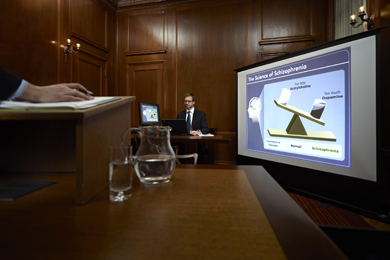Mesmerize the Court: Crucial Elements of a Powerful Trial Presentation
Important components such as understanding the target market, crafting a compelling story, and grasping verbal and non-verbal interaction are vital elements of an effective presentation. As these elements intertwine, they create a natural technique that not only notifies but additionally engages jurors on several degrees.

Recognizing Your Audience
Comprehending your audience is a crucial aspect of efficient trial discussion. A successful discussion hinges on the capability to understand the demographics, values, and proneness of jurors. This comprehension educates exactly how arguments are mounted, proof exists, and psychological allures are crafted, guaranteeing that the message resonates with the jurors on an individual degree.
Research indicates that jurors come from diverse backgrounds and may have varying levels of comprehending pertaining to legal procedures. Additionally, recognizing the jurors' potential prejudices and life experiences allows the trial presenter to anticipate arguments and address problems proactively.
Reliable trial presentation additionally involves observing jurors' responses during the proceedings. Being in harmony with non-verbal hints can offer understanding right into their engagement and receptivity, permitting for real-time modifications in strategy. Inevitably, a profound understanding of the target market not only enhances interaction but additionally develops rapport, raising the probability of a positive outcome. Involving with jurors as individuals instead of a cumulative system is essential in cultivating a strong connection in the court.

Crafting an Engaging Story
Crafting a compelling story is vital in assisting jurors through the intricacies of an instance. A well-structured story not only streamlines detailed lawful ideas however likewise engages jurors on an emotional degree, making the info much more relatable and remarkable.
This message ought to reverberate with the jurors' values and experiences, fostering a connection that goes beyond simple facts. This sequential approach can aid jurors comply with the development of occasions, emphasizing reason and effect.
Integrating human elements-- such as individual tales or narratives-- can even more improve the narrative's influence. These elements evoke empathy, permitting jurors to picture the effects of the instance on realities. Furthermore, utilizing a regular style throughout the presentation strengthens the primary disagreement, making it less complicated for jurors to preserve crucial points.
Inevitably, an engaging story changes a test discussion from a plain address of realities right into a persuasive story that captivates the jury, encouraging them to ponder with both reason and emotion.
Using Aesthetic Aids
Incorporating visual aids into a trial discussion can significantly boost jurors' my link comprehension and retention of info. Aesthetic products such as graphes, layouts, photos, and video clips can change complex lawful ideas and proof into easily digestible layouts. By involving several senses, these aids enable jurors to imagine the case's crucial elements, making it easier for them to follow along and grasp intricate information.
In addition, properly designed aesthetic help can highlight important points and highlight relationships between different pieces of proof. Timelines can properly show the sequence of occasions, while annotated images can make clear particular information appropriate to the case. This not just help in understanding yet also enhances the narrative presented by the attorney.
Overly complicated or chaotic visuals may bewilder jurors and take away from the message. Inevitably, reliable visual communication can be an effective tool in persuading jurors and aiding them reach notified verdicts.
Understanding Verbal Interaction
Reliable verbal communication is critical in a test discussion, as it offers as the main ways with which lawyers communicate their disagreements and attach with jurors. Simpleness in language cultivates understanding and aids jurors realize intricate problems offered throughout the trial.
Furthermore, tone and pacing considerably effect just how messages are obtained. A certain tone shares authority, while ideal pacing permits jurors to absorb info without feeling overwhelmed. Lawyers should also vary their singing inflections to highlight bottom lines and maintain jurors' interest throughout the discussion.
In addition, the company of verbal debates is crucial. Structuring the narrative logically and coherently aids jurors adhere to the attorney's logic, making it less complicated for them to maintain vital information. Using persuasive strategies, such as narration, can also boost the psychological vibration of the arguments offered, thus creating an extra profound link with jurors.
Ultimately, understanding verbal communication not just strengthens an attorney's instance but additionally fosters trust fund and connection with the court, dramatically improving the chances of a positive judgment.

Engaging With Body Language
Nonverbal communication plays a vital duty in trial discussions, commonly special info conveying messages that words alone can not share. Body language, incorporating gestures, posture, faces, and eye contact, substantially influences just how jurors perceive the credibility and genuineness of the presenter. A positive stance, with shoulders back and an open pose, can instill trust fund, while closed-off body language may recommend defensiveness or unpredictability.

Faces ought to show the feelings related to the case, reinforcing the narrative existing. An honest expression throughout a touching minute can generate empathy and reinforce the emotional allure. Eventually, mastering body movement is essential for reliable trial discussions, as it enhances spoken communication and develops a compelling visibility that reverberates with the jury.
Verdict
In final thought, captivating the jury demands a critical strategy that includes comprehending the target market, crafting an engaging story, utilizing aesthetic aids, understanding spoken communication, and engaging via body language. Each aspect plays an essential function in developing an effective trial presentation that resonates with jurors on both psychological and intellectual degrees (trial presentation). By integrating these components successfully, attorneys can considerably boost their ability to convince and influence jury decision-making